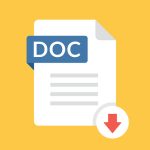Menu
December 20th, 2017
It doesn't matter what kind of law you practice: you're going to need information from your clients while working on their matters. Likely, there will be similar information you're going to collect from every client: maybe their address, or assets, or list of family members. At The Modern Firm, we're all about efficiencies and reducing the non-billable time you spend working. An important step is recognizing when you're spending time doing the same rote tasks with each client. That's a sign that a process might have a technological solution.
Enter a very basic and easy to use technology: an electronic form.

Electronic forms are MAGIC!*
A form is merely a series of standardized questions designed to collect basic information from a client. Paper-based forms are fine, but an electronic form can often speed up the firm's ability to recall that information when needed. Forms help you standardize how you collect and store that information in order to access it later when you need it. (*Electronic forms are not actually magic.)
First, A Caution
It's easy to go overboard with a form and burn out the client, or otherwise make it too difficult to sift through the form at a later date. When your form grows to the point that you have 5 or more optional and/or conditional fields, that's a sign that the form is trying to do too much! Break the form up into separate ones, or otherwise cap the form off and instead ask some questions of your clients directly.
Types of Forms
There are two primary forms (ha!) of collecting form-based information via your website:
Downloadable Documents

After downloading a document your client will need to fill it out and then either print it out or email it to you directly. You should be clear within your instructions in the form or your communications with the client about how you'd like to receive it. Clarity in expectations is key to happy clients!
The Modern Firm can help you create forms using any of the techniques below, but we've found that if you have someone reasonably savvy on staff they can often do it for you too.
The basic options for downloadable forms are Word Documents or PDFs, and Fillable PDFs.
Microsoft Word Document
These can be easy to put together. You'll need to make sure that your clients have access to Word themselves, though, before sending Word documents to them. Nothing is worse for client communication than sending them a document they can't open. Another caution is that giving them a Word document to fill in can result in odd formatting if they're not used to working in Word. That might be fine for your use. We'd recommend not setting up your Word document to rely on them, say, filling out a table correctly, or otherwise using any word processing features other than typing.
PDFs
If you have concerns about your clients having access to Word a PDF is often a better choice. PDFs "lock" the layout and look of your form so you can be reasonably sure it will look the same on everyone's devices. Clients will need to print the form and get it back to you either in person or by emailing it to you.
 Fillable PDF
Fillable PDF
A fillable PDF is a type of PDF designed to accept input from a user in places you specify. After they fill it out by typing on their computer, they can save it and then either print it or email it back to you. You'll need Adobe Acrobat Pro DC in order to make these PDFs. Your clients can then use built-in software on their device or the free version of Adobe Acrobat to fill out the form.
Click here to view or download an example of a fillable PDF.
Fillable PDFs can be incredibly powerful for standardizing how your clients fill out a form. They'll still need to either save and email it back, or print it out and bring it in.
Protected Word Documents

To make a fillable Word document you need to add in fields for the client to fill out. The first step is enabling the "Developer" options in the Ribbon. Within your document you can then insert fields from that Developer tab for text blocks, checkboxes, and dropdown menus. Then "Protect" the document and save it to a separate file. A client will only be able to modify the fields you've added and nothing else.
Click here to download an example of a protected word document.
Embedded Online Forms
An online form lives on your site and allows a client to fill it out and click submit; the form will then generate a nicely formatted email you. You've likely seen forms like this on sites that ask for your name and email, and let you send a message to the business. We almost always recommend that your site have a contact form like this for clients to get in touch with you if they don't want to email or call directly. Beyond that simple use, you can also use an online form to collect more sophisticated information from a client. And, if you want to get fancy, you can have conditional questions built into the form. For example, if they indicate that, yes, they have a vacation home, you can then show a field that requests more information about the cost and location of that home. Here's an example of a form like this:
Submit a "Question of the Week"
Thank you for taking the time to submit a question. Not all questions will get published on our website, but we'll try our best to answer it for you personally regardless of publication.
Online forms take more work to put together at the outset. We've found that they can have a huge positive administrative impact. They're straightforward to use and, once submitted by the client, the information is immediately sent in a readable digital format directly to your email.
When a Form Isn't Appropriate
While we're big believers in forms, we also recognize that they are certainly not always appropriate for every kind of client. High-touch clients might expect that someone would ask them these questions directly, or otherwise do more legwork on their behalf. You know your clients best and should tailor your intake process to fit their needs.
But just because you conclude a client shouldn't be asked to fill out one of your fancy forms directly doesn't mean you can't have a staff member fill it out on their behalf. This ensures that you're collecting the right, basic information for each client and streamlining the administrative process for their matter. After all, all a form does is ensure you can answer basic questions easily, freeing you up to use your time on more interesting problems and the actual case at hand. Collecting information isn't an end in itself, it's a means towards serving your clients.
Categories: Question of the Week
Tags: Website Design





